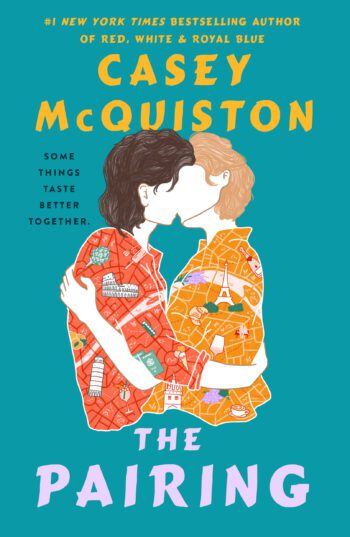
If The Pairing (St. Martin’s Press, 2024)had a mission statement, I imagine it would be “SLUTS FOREVER!” tagged in neon on the biggest yacht in Monaco. Casey McQuiston’s fourth romance is a novel of excess: a whirlwind of long, sticky summer days, dirty jokes, and hand-painted frescos. It’s the author’s most ambitious work yet and certainly their spiciest (genre-speak for most sexually explicit). At its core, romance is pleasure-reading. The Pairing is a paean to the genre, a celebration of pleasure in its many forms––art, wine, food, sex––and a portrayal of queer intimacy that expands the possibilities for romance as a genre.
The novel follows two estranged bisexual exes who reunite on the European food and wine tour they booked pre-breakup, after inadvertently redeeming their vouchers for the same trip. Theo Flowerday is a Hollywood nepo baby and aspiring sommelier; Kit Fairfield is a French pastry chef and Rilke enthusiast. Theo and Kit are still in love, despite their attempts to pretend otherwise. Their romance follows a trope sequence familiar to romance fans—childhood friends-to-lovers-to-enemies-to-friends-to-lovers again—that sustains the narrative’s driving tension. Every turn in Theo and Kit’s relationship, from the mutual longing of childhood friends to the friction of enemies, heightens the anticipation before delivering on the genre’s promise: the happily ever after.
McQuiston’s previous novels had higher stakes. In Red, White & Royal Blue, the American President’s son falls for the Prince of Wales. Their sophomore effort, One Last Stop, is a time-travel romance. Even the author’s YA debut, I Kissed Shara Wheeler, involves a search for a mysteriously vanished prom queen. In The Pairing, Kit and Theo compete for the most hookups on their trip––making the novel a pure pleasure ride. The language is playful and pop culture-savvy, with references ranging from Ravel to Robyn and Kate Winslet to Caravaggio. Kit narrates that he is “half agony, half hard”—a sly nod to Persuasion. Many romances are page-turners, propelled by the rising tension between their characters and the reader’s desire to reach what feels like an inevitable conclusion. The Pairing unfolds at a slow, deliberate pace, spanning Kit and Theo’s three-week itinerary. In Saint Jean-de-Luz, buildings “cuddle together around narrow streets.” In Riomaggiore, characters enjoy a spread of “fileted anchovies brined in lemon and olive oil, squids braised in their own ink, herbed octopus, cuttlefish.” Even with Kit and Theo’s reconciliation in sight, readers can savor every image along the way.
McQuiston is eager to expand the romance reader’s view of queer intimacy. Theo, their first trans protagonist, often desires Kit while he is being intimate with or expressing attraction to another man. Through the novel’s sex scenes, Theo’s gender emerges as a complex facet of their queer identity. “Sometimes when I’m on top of Kit,” they narrate, “I feel more present in my skin than I ever have. All the pieces in their right places.” In The Pairing’s most striking passage, Theo and Kit have one-night stands in neighboring apartments, separated only by an alleyway. As the encounters grow louder, they intertwine in Theo’s narration: “On the next swipe of my tongue, I hear three simultaneous gasps: Caterina with her knee hooked over my shoulder, Kit across the alley being sucked off by another man, and Kit bent over our old kitchen counter with my spit sliding down his thighs.” Reading it, I thought, Is this allowed? Kit and Theo experience a profound, shared intimacy through their separate encounters. Few romance novels hit such emotional and sensual highs with the leads physically apart; fewer still so elegantly capture the fluid contours of gender and desire.
Theo’s gender also informs the novel’s narrative strategy. The Pairing is a dual point-of-view romance, split between Kit and Theo’s perspectives.In the first half, Theo’s first-person narration suggests they’ve moved from contending with their gender identity to fully embodying it––a change that occurred in their time away from Kit. While Theo’s arc sidesteps the classic coming-out narrative––echoing the author’s ambivalence about that framework––the novel builds toward a pivotal moment in its second half, when Theo opens up to Kit: “I don’t necessarily see myself as any particular, static thing, but if I have to pick, non-binary is the closest. Definitely some shade of trans. I just know I’m a lot of stuff, but one thing I’m not is a woman.”
From that scene onward, Kit’s starts using they/them pronouns for Theo instead of she/her and, significantly, never switches back. Romance has long adhered to binary gender norms and heterosexual dynamics––stories that go boy meets girl or, on occasion, boy meets boy. McQuiston frames Kit’s linguistic shift as pivotal in his relationship with Theo, marking the point where Kit begins to integrate Theo’s gender identity into his understanding of them. “I don’t know if I love Theo because I’m queer or if I’m queer because I love Theo,” he narrates, “but I know there’s nothing I need that Theo doesn’t have.” It’s a vision of intimacy that feels uniquely possible within queer relationships, one that transcends gender but remains firmly rooted in it, honoring every nuance as central to Kit and Theo’s connection.
“Sex is better when the person you’re with really understands you, and understands how to look at you,” Theo tells Kit. A romance novel is better, too, when it reveals the way queer love pulls the hidden parts of its characters into view––how it can feel affirming, transformative, and deliriously abundant. In The Pairing, that’s precisely the point: love can make the world feel wider than before.




